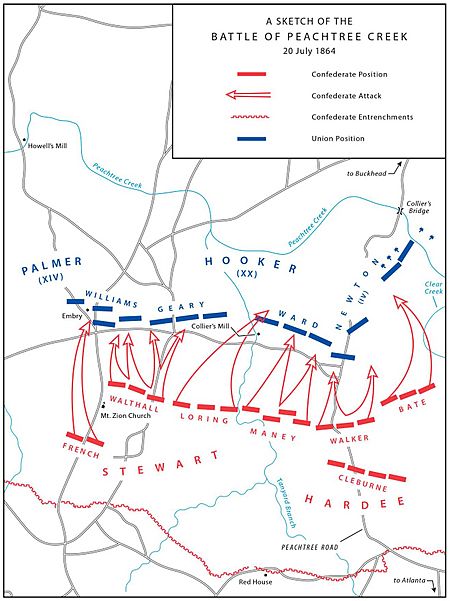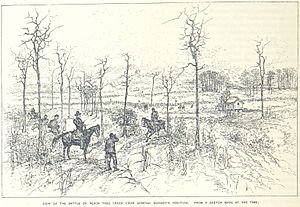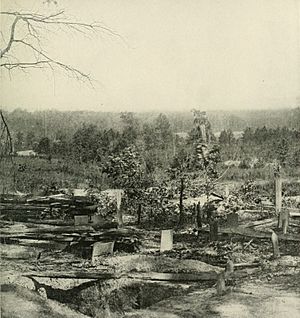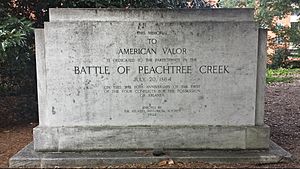Battle of Peachtree Creek facts for kids
Quick facts for kids Battle of Peachtree Creek |
|||||||
|---|---|---|---|---|---|---|---|
| Part of the American Civil War | |||||||
 "Few battlefields of the war have been strewn so thickly with dead and wounded as they lay that evening around Collier's Mill." (Union Major Gen. J. D. Cox) |
|||||||
|
|||||||
| Belligerents | |||||||
| Commanders and leaders | |||||||
| Units involved | |||||||
| Army of the Cumberland | Army of Tennessee | ||||||
| Strength | |||||||
| 21,655 | 20,250 | ||||||
| Casualties and losses | |||||||
| 1,900 | 2,500 | ||||||
The Battle of Peachtree Creek was a major battle fought in Georgia on July 20, 1864. It was part of the important Atlanta Campaign during the American Civil War. This battle was the first big attack led by Lt. Gen. John Bell Hood. He had just taken command of the Confederate Army of Tennessee.
Hood's attack was aimed at Maj. Gen. William T. Sherman's Union army. The Union forces were getting very close to the city of Atlanta. The main armies fighting were the Union Army of the Cumberland, led by Maj. Gen. George Henry Thomas, and two groups from the Confederate Army of Tennessee.
Contents
Why the Battle Happened
In early May, General Sherman started a big plan to attack the Army of Tennessee. For over two months, Sherman's armies fought against the Confederate Army of Tennessee. This Confederate army was then led by General Joseph E. Johnston.
Even though the Confederates won some smaller battles, they could not stop Sherman. He had more soldiers. Union forces kept moving around the Confederates' defenses. On July 8, Union soldiers crossed the Chattahoochee River. This was the last big natural barrier before Atlanta.
A Change in Command
General Johnston pulled his troops back across Peachtree Creek, just north of Atlanta. He planned to attack part of the Union Army as they crossed the creek. But on July 17, he got a message from Confederate President Jefferson Davis. The message removed him from command.
The Confederate leaders were not happy that Johnston was not aggressive enough. They replaced him with General Hood. Hood was known for being very brave and attacking fiercely. He had even been injured in battle twice before. Hood officially took command on July 18. He quickly launched his planned attack.
Sherman's Plan and Hood's Response
On July 19, Hood learned that Sherman's armies were splitting up. Thomas's Army of the Cumberland was moving straight toward Atlanta. Meanwhile, other Union armies were moving east to attack from a different direction. This was part of Sherman's plan to cut off Confederate supply lines.
Thomas's army had to cross Peachtree Creek in several places. This made them open to attack. Hood hoped to attack Thomas while his soldiers were still crossing the creek. Hood also sent other Confederate groups to meet the Union forces coming from the east. He wanted to push Thomas's army away from the other Union armies. This would force Sherman to change his plans for Atlanta.
Who Fought in the Battle
| Army Commanders at Peachtree Creek |
|---|
|
Union Forces
Confederate Forces
The Battle Begins
On the morning of July 20, the Union Army of the Cumberland crossed Peachtree Creek. They started setting up their defenses. The XIV Corps was on the right side. The XX Corps was in the middle. A part of the IV Corps held the left side. The Union soldiers were still building their defenses when the Confederate attack started.
Confederate Attack
The Confederates had a chance to attack before the Union defenses were ready. Hood sent two of his three groups to attack. General William J. Hardee's group attacked on the right. General Alexander P. Stewart's group attacked on the left.
Hood wanted the attack to start at 1:00 PM. But there was confusion and bad communication between Hardee and Hood. Hardee's group moved too far east. Stewart's group also moved east to stay connected. The attack did not start until 3:00 PM.
The Confederate attack finally began around 4:00 PM. On the Confederate right, Hardee's men faced strong resistance. They could not move forward much and lost many soldiers. This part of the attack failed because of mistakes and not knowing enough about the area.
On the Confederate left, Stewart's attack was more successful. Two Union groups were forced to retreat. Many soldiers from the 33rd New Jersey Infantry Regiment were captured. A Union artillery battery (a group of cannons) was also captured. Union forces fought back hard. After a tough fight, they stopped the Confederate attack. Union cannons helped a lot on the left side.
Aftermath
A few hours into the battle, Hardee was ready to send in more soldiers. But Hood sent an urgent message. He told Hardee to send those soldiers to help another Confederate group that was under attack.
The Union lines bent but did not break under the Confederate attack. By the end of the day, the Confederates had failed to break through anywhere. Hood pulled his troops back into Atlanta's defenses the next day, July 21. About 4,250 soldiers were killed or wounded in total. The Union lost about 1,750 soldiers, and the Confederates lost at least 2,500.
What Historians Say
Many historians have criticized the Confederate plans and how they carried out the battle. They especially point to Hood and Hardee. General Johnston, even though he fought defensively, had already planned to attack at Peachtree Creek. His plan was to strike the Union Army as it crossed the creek.
Replacing Johnston with Hood, right before a big battle, is generally seen as a mistake. Hood and other generals even sent a message to President Davis. They warned him that it would be "dangerous to change the commander of this army at this particular time."
Hood's general plan to attack the divided Union forces made sense. But his soldiers were not in position before the Union crossed the river. Hardee did not fully commit his troops. Hood also kept attacking even after he lost his advantage. All these reasons led to a clear defeat for the Confederates.
Heroes of the Battle: Medals of Honor
Some soldiers showed amazing bravery during the Battle of Peachtree Creek. They were awarded the Medal of Honor, which is a very high award.
- Lieutenant Colonel Douglas Hapeman was honored for his bravery. He rallied his men during a strong attack. He brought his broken lines back together and pushed back the enemy.
- First Lieutenant Frank D. Baldwin was also awarded the Medal of Honor. He moved ahead of his own men under heavy fire. He went into the enemy's lines alone. He captured two armed officers and a flag from a Georgia regiment.
- Private Denis Buckley received the Medal of Honor for capturing the flag of the 31st Mississippi (Confederate States of America) regiment.
What Remains Today
Most of the battlefield today is covered by city buildings. Tanyard Creek Park is near where the center of the battle was. It has several memorial markers. Peachtree Battle Avenue is a street that remembers the battle. These places are in the northern part of Atlanta called Buckhead. The play Peachtree Battle is a comedy about life in this fancy area.
In Popular Culture
- The book Shattered Nation: An Alternate History Novel of the American Civil War by Jeffrey Evan Brooks is about the Battle of Peachtree Creek. In the book, General Johnston leads the Confederate Army instead of Hood.
- On the TV show Who Do You Think You Are?, actor Matthew Broderick found out that his great-great-grandfather, Robert Martindale, was killed in this battle.









